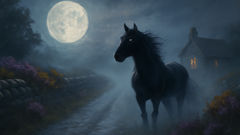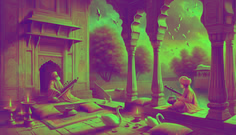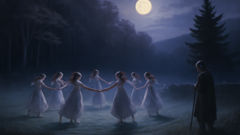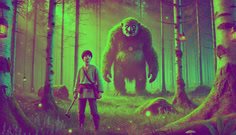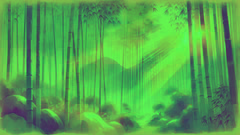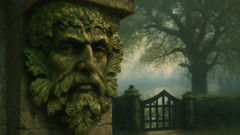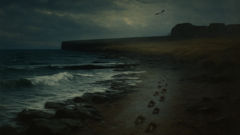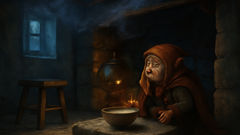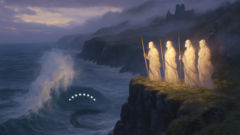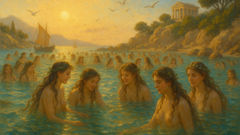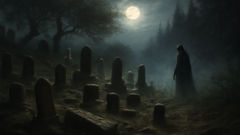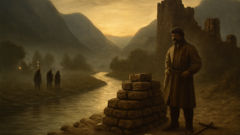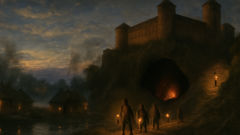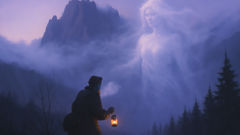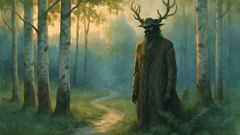Introduction
There is a hollow of the world where fog sits like a thought and the land remembers the footfalls of animals and stories. The valley of Darragh once held more than sheep and stone; it kept a ledger of names, a ledger made of hedgerow, stream, and the small curses people muttered into their cupped hands when a plan failed or a child misbehaved. The Púca lived in that ledger, not as a single thing but as a remainder, a flaring of possibility at the edge of sense. On some nights it was a horse with eyes like wet coal, on others a smirking man with too many teeth, once a goat that hummed in the manner of distant church bells. Folks said it was a spirit, kin to the fair folk, or else a devil sent to teach children to mind their steps. Old mothers warned their young to leave a bowl of milk by the threshold and a twig by the hearth to keep the Púca from taking a night ride on a sleeping body. And yet, for all the fear and for all the boiling of porridge spiked with salt to keep mischief at bay, the Púca bore a more complicated tongue than the village could translate. It delighted in the unstable angles of human lives, the hinges of choice, and the small acts that could be undone by a hoof, a whisper, or a sudden change of skin. In these pages I will ask the valley to remember what the Púca was and what it meant to the people who shared the land with it, to walk through moor and lane, to listen for the tread of hooves at dawn and the rustle of goat hair in the gorse, and to weigh mischief against mercy in a landscape that rarely offered easy answers.
Origins and Omen
The valley remembered the Púca before it had a name, and names changed the nature of things. In the oldest telling, which the seers and the slow-tongued mourner-chant keepers preserved by speaking into peat-dark nights, the Púca arose when the boundary between the human and the more-than-human was brushed by sorrow. A child had been taken by fever in a year of poor barley, and the wild places had answered the family's wailing by turning one of their own loose. Whether the creature sprang from grief or from the tilt of the stars matters less to the people who live with signs than it does to scholars; what mattered to them was that the Púca arrived as an errand and as a riddle. It offered the mechanisms of change: a night ride that could lift a man free from a bad dream, a broken cart suddenly fixed, a lover glimpsed and then denied. Those who met it carried away a bruise of story and the knowledge that the world had agency.
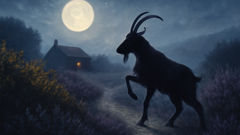
People in the valley made rituals almost by accident. When the harvest failed, they left out bowls of milk; when livestock calved oddly, they placed twigs and stones in patterns to confuse what might take a fancy to the newborn. The Púca liked patterns, and it admired the small arithmetic of human superstition. These acts became a language, a back-and-forth: humans made offerings, the Púca tested boundaries, and communities adjusted their etiquette accordingly. Some called it guardian, others called it a trickster, and a few, with eyes that had watched the hard edges of hunger, called it cruel. The identity of the Púca changed with every story told beside a peat fire. To the landlord who wanted to keep his breadth of ground, it was an agent of chaos; to a solitary widow, it was a phantom that sometimes freed her grief to be remembered in waking hours.
Yet the Púca failed sometimes, and failures were instructive. Once it took the form of a goat to tempt a young lad away from a cliff path, but the lad did not follow. The goat returned to find its hoof broken against a stone and the lad still alive. The Púca's embarrassment was not a human emotion so much as a misalignment in the world, an error in the ledger. When a trick did not stick, the creature retreated and watched until the pattern of alehouse laughter or prayer repaired itself. These misfires bred the great lake of skepticism among the more cautious folk: if the Púca could be foiled by a single twig or a sudden kindness, then perhaps mischief could be met with small, deliberate goodness.
There were songs about the Púca that children hummed badly, fragments of rhythm that taught them the necessary evasions. They said do not ride a strange horse at dusk, do not mount a stranger's back even if they offer you fine silver; place salt at your thresholds, speak true names when the moon is thin. Names mattered because naming held a thing to a place. A farmer could not simply call his field fertile and expect the world to comply; he had to mark it, give thanks, and speak its boundaries aloud. The Púca listened to these names the way a river listens to rain, and sometimes it answered with a sound that was like hooves on wet stone or the bleat of an animal so far away it could be mistaken for the wind. This was the way the valley taught itself caution and a sort of reverence. In time, the Púca became a mirror for the people of Darragh: a creature that reflected the best and worst of how the community treated the land and one another.
Not all encounters were ominous. A midwife once claimed that when the first child she delivered in a year of frost screamed and would not stop, she heard a soft footfall at the doorway and a warm breath across her wrist. She set a cup of sweet milk on the sill and found, at dawn, the milk untouched but the child sleeping. The midwife told no one at the time, but the story seeped into the village like a slow bloom. It suggested the Púca had a code that might at certain hours be generous, trading terror for aid in a single breath. The stories that hardened into law were harsher: do not leave gates open, do not travel alone at sundown, do not take what is not yours. But a shadow story persisted, one that showed the Púca as a creature that kept an odd balance between admonition and assistance. The very ambiguity ensured it would live on in tales that grew and split like roots.
Rituals evolved out of domestic necessity and local theology. People began marking roads with stones carved with crosses, sometimes to appease saints, sometimes to confuse a Púca that might be tracking a particular scent. Horses were blessed on certain days, not by priests alone but by cottage women who hummed and pushed their hands over the animals' flanks. Even the earth itself was tended like a temperamental neighbor. The Púca responded to attention. Where hedges were mended and lanes widened by careful feet, the creature tended to behave in ways that preserved those places; where care was lax and bitterness sour, it multiplied its mischief. The moral of those older tales is not a single sentence; it is a braided truth that responsibility and care make the wild less destructive and the wildness less an excuse. The Púca was a kind of social thermometer, reading the temperature of the land and the people who lived on it, telling them, by hoof or whisper, when their warmth was ebbing.
As the world outside the valley pushed in with new maps and new laws, the Púca adapted, or else the stories that reached outside adapted the Púca. Travelers and tinkerers carried the name into towns and ports, where it became a jest or a pinprick of fear to bring to children who had never known the peat-scent of home. In those retellings, gallows humor and folklore fused; the Púca became a punchline and an omen. But in the valleys where hedgerow still held its memory, the old dances continued: the leaving of milk, the placing of a thumb-sized stone under a threshold, the avoidance of strange rides after sunset. People learned to live with an intelligence that could be called malicious or merciful depending on how well they remembered to tend their world. This balance shaped the valley's identity, and the Púca, as both mirror and mischief, made sure that identity was never quite static.
Encounters in the Valley
People in the valley told stories of encounters the way sailors told of storms: with detail that aged toward myth and specifics that kept small truths. The butcher's boy who had seen the Púca as a black horse described the animal's breath as smelling of bracken and old rain. He spoke of a night when, drunk with the bravado of youth, he had swung his leg over a stallion's back and felt the world tilt. The horse's hooves scored the road like a drum and the boy's laughs became a thin and distant sound. He did not return until morning, when he was found curled behind the village well, groggy and smeared with bog-ash. He had, he said, ridden to the ridge outside Darragh and back in an hour that his watch falsely insisted lasted all night. The village listened and told him the moral they preferred: do not trust unknown animals. But others who had witnessed different outcomes countered with quieter stories where the Púca carried someone away from danger rather than toward it.
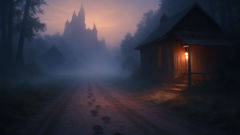
Children were always a focus of the Púca's tales. They were, according to the oldest mothers, more porous to the more-than-human. A child who listened to the croon of a strange goat might follow it, their small hand slipping through gullies and into someplace the elders called no place at all. Stories of children seduced by song hardened into rules. Yet there were also accounts of small children brought back from blighted places, cheeks flushed and eyes full of secret sky. One such account came from the family of Oonagh Keane, whose youngest boy fell into a fever and rose ragged and smiling after a night of unremembered absence. He recited, in a child's altered way, fragments of a road lined with lanterns and a voice that smelled of hay and old bread. Oonagh kept a careful silence on whether she believed the boy's claim; belief, she knew, made the world a different shape.
Farmers learned their own evasions. When a field refused to yield, elderly workers walked the hedge-rows with bells tied to their belts and twigs braided with hair to confuse a Púca that might be sprouting mischief from the roots of frustration. Such practices illustrate how human habit rearranged the creature's pattern. Over decades, certain lanes in the valley gained reputations: a bend called Fox's Mercy where travelers swore they had been followed by a laughing man with joints that bent too far; a hollow named Bride's Lull where a mare broke into a run without the urging of rider or whip and returned with foal newly crowned by stars. These micro-histories formed the valley's atlas, a map not of towns and taxes but of vulnerability and grace.
The Púca also haunted the relationships between neighbors. When two families disputed a strip of common, the animal would sometimes take a shape that exacerbated fear until the dispute burned itself out. In these tales revenge was often thinly veiled as fairness. A quarrel over grazing rights might end with one family discovering their best cow gone and a bruise of hoofmarks in the dew. The missing cow would return, oddly fat and clean, days later. The neighbors would accuse each other and then stop accusing when the Púca appeared again in a shape that made both parties flinch. These awkward interventions encouraged settlements. The logic seemed to be that the landscape preferred bargain to blood, and the Púca, for reasons inscrutable to human law, tended to facilitate bargains by making small examples of those who refused to remember their dependency on each other and the ground beneath them.
Priests and poets argued about the creature as if they could civilize it with doctrine or definition. Some priests preached against paying heed to such spirits, asserting that piety and prayer would render the Púca impotent. Poets, on the other hand, gave it personality and motive, spinning it into a figure that punished only those who deserved it. The villagers privately ignored most such debates and attended to the practicalities: fences mended, offerings made, children kept within arms reach after twilight. Stories passed between neighbors like recipes for weather: tried, adjusted, and passed on. It was the slow and stubborn practice of living with the unknown that formed the valley's wisdom.
Not every encounter left a mark of fear. There were nights of laughter in which a ragged group of harvesters swore a dark horse broke their row of scythes into a smooth song and then vanished with a snort that could be heard like a man clearing his throat. The men told the story in the pub as one might tell of a miraculous catch, embellishing and softening the edges, until even skeptics nodded at the humility of small, unbought joy. Such events knitted the community together in a way that a single, stark tragedy could not. The Púca, in those versions of the narrative, acted less as punisher and more as an instigator of perspective, reminding people how scarce and sudden delight could be in a life of careful labor.
One of the most persistent encounters was that of the night rider. Tales held several consistent features: a strangerly cavalcade out of the fog, the thunder of hooves returning empty dawns, and those who woke to find their saddles gone or their boots left soaking by the hearth in puzzling arrangements. These stories served as metaphors for risk and reckoning. A man who rose to find his fields sprouting better than the year before might attribute it to a ride he did not remember; another, who returned with a scar that would not close, might see in that scar an account of some debt unpaid. The Púca's rides thus became a ledger: payments made, unpaid, or mysteriously remitted by a creature whose accounting the living could not wholly understand. Through such stories, the valley maintained balance: by attending to its own small debts and by acknowledging that the land might itself judge the ways in which it had been treated.
Over time, as the village aged and younger people left for ports and cities that promised steady wages and new maps, the stories altered again. City minds turned the Púca into spectacle, a subject of paper and exhibition rather than a neighbor to be negotiated with. But the valley kept its half-suspicions and half-respect like combings of hair from an old garment. Even those who left carried a kernel of the tale back into their new lives, telling it in rooms where peat smoke was a rumor and moonlight was an imported template. The Púca, in consequence, became many things to many people: a warning, a marvel, a joke, and, for the stubborn, a reason to keep hedges mended and thresholds salted. It thrived best where the land was neither forsaken nor manicured beyond recognition, in the liminal places where story and weather cross-pollinated and where people still left milk on the sill out of habit rather than superstition. The encounters continued, and so did the work of translating them.
Finally, in these encounters, the Púca taught one steadier lesson than the rest. It insisted that human attention changes the world. When care is given—when fences are fixed, when gossip yields to tending—the Púca's mischief waned. When neglect, greed, or cruelty ruled, the creature became more active and more pointed. This is not a tidy moral but a practice: attend to the land and to one another and you will find that curiosity becomes less dangerous and more instructive. Those who listened to such stories learned to live with less certainty and more patience, understanding that a valley will always house more stories than one person can hold and that some creatures exist to complicate rather than to conclude the human business of meaning-making.
The Night of Reckoning
The night of reckoning came not as an event so much as a concatenation of small erosions. Years of neglect had broadened a stubborn rift between two families who had once shared winter work and bread. The dispute began over a strip of marsh where rushes grew thick and useful. It stretched and hardened into quarrel, and quarrel into vandalism: fences torn, tools misplaced, insults scrawled on doors. The land suffered and the animals responded with headaches and strange births. It was the kind of slow poison that gets swallowed by routine until someone wakes and realizes the taste has changed. In a valley that prided itself on the slow, communal mending of such harms, this breach became a wound everyone could see.
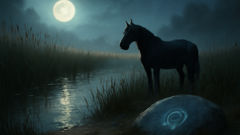
When a herd of cows broke into a field and came back with hair tufts missing and eyes far distant, the village council convened at the pub and then at the church, as was custom. They debated a cure: legal action, priests' intercessions, or a communal sacrament of apology. But the Púca had a different idea. It arrived that night as a riderless horse wearing a tack of woven bracken and silver thread. It walked the boundary between the two properties and then chose a route that was neither map nor law. The Púca performed tiny interventions: a gate latched itself, a hand found a misplaced tool, a child's toy rolled out from under a shed with an odd, deliberate timing. These were small miracles, and they did not all point to repair. They were, rather, a series of nudges that refused to say whom they favored. In the morning, both families discovered that their hens had lined up along the disputed marsh's edge and begun to cluck in a syncopated rhythm. The villagers took this as a sign: the land was asking for a truce, or at least for attention.
What set the night apart was a more unsettling occurrence. A man named Tomas, who had been particularly fierce in speech and bitter in deed, went out after midnight to check his boundary stakes. He reported coming upon a sight that left the whole village shaken: a procession of shapes that might have been riders, might have been trees, passing through the marsh with a sound like a sea of reeds. One of these shapes detached itself and stood beside him, and Tomas saw it in the figure of a man with a face like cracked leather and eyes that burned white. The Púca, in this account, did not speak but pressed Tomas's palm to a stone and left an impression of a hoof on his skin. Tomas carried that imprint through waking weeks, and it itched like a promise. He felt watched and then slowly, reluctantly, ashamed. Whether the hoof-mark was an illusion, a fever dream, or a verdict from the land mattered less than the fact that it altered the man's behavior. Tomas returned his neighbor's tools, mended fences without complaint, and ate his meals in more measured silence. The community noticed change and then believed it had been effected by something beyond their small councils.
The Púca's verdicts are more like mirrors than edicts. They reflect what a place has allowed and what it needs. After the night of reckoning, people began leaving more than milk: bread laid at crossroads, strings of barley on thresholds, small parcels of salted meat placed into hollow trees. Some of these acts were appeasement, others offerings, and some purely pragmatic measures to ensure animals did not wander into mischief. The distinction mattered to those who thought they might be changing their fate by doing good deeds or by earning favor. But the older women who had kept the stories for everyone agreed on an older calculus. They said the Púca had no ledger of credit but rather an appetite for balance. If injustice had tilted the valley's scale, the creature nudged until equilibrium returned. It nudged with teeth and laughter, with hoof and whisper, until the people recalibrated themselves.
After the repairs, the marsh changed. Rushes that had been stunted grew tall enough to support a new path. The field produced a harvest solid and surprising in a year when neighboring lands faltered. This did not prove the Púca's benevolence so much as the valley's capacity to heal when its people remembered how to tend it together. The tale hardened into a parable for cooperation. Young and old would later tell the story as an example of how leaving greed unchecked makes the wild respond in ways that cannot be constrained by court or sermon. The Púca was neither judge nor savior; it was, in this telling, a messenger that preferred improvisation to simple moralizing.
The more reflective villagers used the episode to examine the nature of fear and accountability. They set new patterns for negotiation: a monthly meeting in the green, a list of communal tasks that rotated through households, and a binding oath of sorts that every harvest would produce a required portion for shared use. These practices were not only practical but also performative. The village staged care for itself so the Púca would feel less need to stage discomfort. In these rituals the community learned a discipline of attention: it takes work and good humor to maintain relationships with the living and the more-than-human.
In some later retellings, the Púca grew kinder; in others, it became sterner. The marrow of the lesson, however, remained constant. When people neglected their responsibilities to land and neighbor, the world made itself known in awkward, sometimes violent ways. When those responsibilities were met, the world softened. The Púca here acted as a weather vane of human behavior, turning to face the winds of neglect and then pointing them away when mending began. The story is less a moralist's sermon than a practical theology: the ground will remember how it was treated, and it will act upon that memory.
As seasons turned, the memory of the night of reckoning smoothed into local custom. Children learned to chant the names of the boundary stones so that they would not be forgotten. Farmers walked the hedges together twice a year. Old Tomas kept his hoof-mark for the rest of his life, a pale crescent on his wrist that made children stare and strangers ask questions they were too polite to finish. He told them, when asked, that the Púca had a way of making people honest when honesty was cheapest. Whether he believed the story as supernatural or as a narrative that changed how he lived mattered less than how he altered his days. The valley regained a kind of balance, imperfect and fragile, that required tending like any living thing. The Púca receded into the hedges, content, perhaps, with the knowledge that it had done its work and returned the ledger to a state where human hands could once again write on it without fear of instant correction.
That is how the valley taught itself to live alongside a creature that thrived on uncertainty. The Púca remained a presence, sometimes a problem, sometimes a proverb. People kept leaving milk, they kept their gates latched, and they kept telling the story as they walked from field to field, teaching the next generation the craft of attention. The night of reckoning closed with an odd peace: the realization that disturbances had a purpose and that repair required humility. In those years the valley remembered to tend not only its fences but its stories, ensuring that the tale of the Púca became less a source of terror and more a repository of shared sense.
Conclusion
Stories endure because they work on the heart in the way that weather works on the land. The Story of the Púca is not simply about a mischief-making shapeshifter; it is an account of how a community learns to live in the tension between care and neglect, between superstition and practical kindness. The Púca refused tidy categorization. At times it punished, sometimes it aided, and often it acted as a provocateur, showing people the consequences of their actions by rearranging their world. The many versions of the tale remind us that the boundary between wonder and fear is porous and that narrative itself is part of the labor of tending the world. If there is a moral it is a practice: to mind your thresholds, to mend your fences, and to remember that attention changes outcomes. In that remembering lies the truer sort of magic, the kind that makes hedgerows flourish, children return from the margins, and neighbors find reasons to sit together by the hearth. Live with care, and the Púca's mischief will most often be a prompt toward mending rather than ruin. Let neglect fester, and the land will speak in its own language until the human listeners finally learn to translate.

